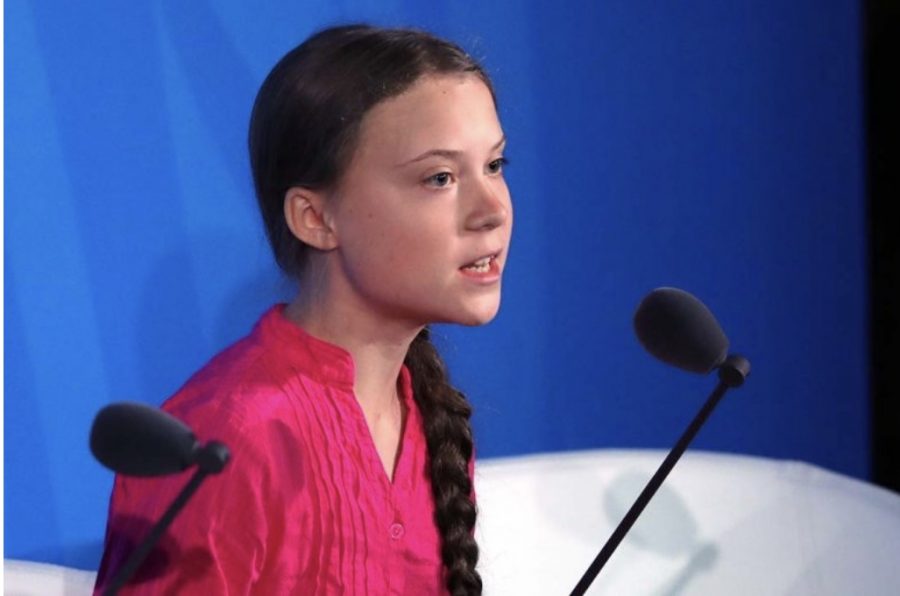An Explanation Behind the Climate Change Movement
November 15, 2019
“There is a magic machine that sucks carbon out of the air, costs very little, and builds itself. It’s called a tree…. They take carbon out of the air and lock it away. Nature is a tool we can use to repair our broken climate…” says George Monbiot, a British environmental activist. It was part of the video published by The Guardian newspaper on September 19th and shared through social media sites such as Instagram to spread awareness of global warming. Greta Thunberg, a Swedish teenage environmental activist, was also part of this video. Together, they are part of a growing movement to raise awareness and demand action on climate change.
On September 23rd, Thunberg made a powerful speech at the Climate Action Summit 2019 at the United Nations. Her speech was directed toward “careless” adults, emphasizing her points with the phrase, “How dare you.” She criticized the adults’ and politicians’ ignorance of the environmental crisis, now appearing at an alarming rate. She said, “…Entire ecosystems are collapsing. We are in the beginning of a mass extinction and all you can talk about is money and fairytales of eternal economic growth! How dare you!…. We will never forgive you.” These impactful words have influenced many adults and teenagers around the world to become more aware of global warming and climate crisis occurring on a massive scale.
For instance, on September 20th, almost 1,200 students around the Capital Region participated in the Albany Youth Climate Strike at the New York State Capitol. One was Ursula Wolfe, a sophomore student at the Albany Academy for Girls. She said, “…It was amazing to see so many kids there…. Seeing a crowd that was so diverse but still so united on one goal was very touching to see.” There were also many inspiring quotes held up on posters, like, “One Earth = One Chance”, “Respect Nature, Teach Sustainability”, and “For my grandson’s future” etc.
As attempts to spread awareness of the environmental crisis is still on the rise, some examples of recent crises are the rainforest fires in the Amazon and the Indonesian island of Sumatra. First, the Amazon rainforest, the world’s largest tropical rainforest, occupies more than two million square miles in South America. As massive as it is, it’s known to absorb more than 25% of carbon dioxide in the air, the amount of which has increased greatly since the 1800s. Unfortunately, the Amazon rainforest, also characterized by its huge biodiversity, has been experiencing wildfires throughout the year. The main cause was the clearing of land by controlled burns and deforestation for agricultural purposes and mining of oil and gold. These fires were exacerbated by it being the dry season. Thunberg commented on this fire, according to AFP news agency, “It is a clear sign that we need to stop destroying nature… Amazon is such a key to addressing the climate crisis…” Robert Bischoff, upper school math department chair and teacher of the new Human Ecology course, provided additional information about deforestation and its detrimental effects. He said, “Without trees, the soil would lose its nutrients and transpiration would stop, which also impacts other ecosystems and their water cycles. Water runoffs will also erode the soil, in which case the ecosystem can no longer be a rainforest but grassland. It will also take a long time for the regrowth of new trees.” According to the BBC, the Amazon fires have eased since its peak in August, but it is continuously under danger for more fires.
Deforestation is also prominent on the Indonesian island of Sumatra. By 2010, 70% of the forested area on Sumatra had been converted for various purposes, including plantations, as Indonesia is the world’s largest producer of palm oil that draws huge financial profits. This resulted in the temperature in the nearby Jambi province was found nearly two degrees Fahrenheit (a large difference) higher in 2015 compared to 2000. Possible attempts are being made to solve this problem. These include spreading awareness to boycott certain makeup products and developing certifications proving products don’t come from deforested lands like RSPO (Roundtable on Sustainable Palm Oil), which was joined by Nutella.
As has been noted, although there have been numerous attempts over many years to spread awareness, stop environmental destruction, and set governmental bans regarding the burning of deforested lands, an official and definite solution has yet to emerge. However, according to the Center for Climate and Energy Solutions, there have been government actions such as developmental programs like the Advanced Research Project Agency-Energy, that continuously study ways to reduce carbon dioxide emissions regarding new technologies and bring them to commercial use. The deforestation must stop and environments should be more protected for the healthy living of both ourselves and the organisms around us.


